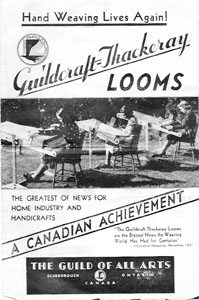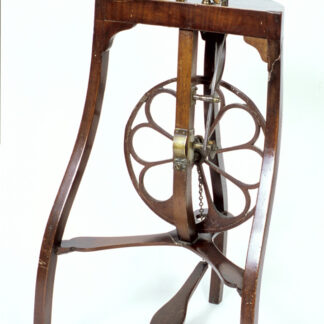
A Fly-Shuttle Rocker-Beater Loom
Phyllis Dean has been studying rocker-beater looms for almost 20 years. She was surprised to discover one that had a fly-shuttle mechanism built into the loom structure. She describes the unusual features of this loom and the challenges involved in restoring it.

Fly-Shuttle Rocker-Beater Loom front view

Close-up of trigger sticks

Side view
Frank Ogden, Master Weaver
Phyllis also tells us about the loom’s owner, Frank Kelsey Ogden [1868-1948], who had a weaving business in Draper, PA.
![1899 Tioga County [PA] directory listing](https://www.spwhsl.com/loom2016/ogden-1.jpg)
1899 Tioga County [PA] directory listing
A Weaving Apprenticeship
As part of a program sponsored by the New Hampshire State Council on the Arts, Craig Evans and Diane Howes did a traditional craft apprenticeship at the New Hampshire Farm Museum in Milton, NH. They set up their early 19th-century looms at the museum and wove traditional fabrics with natural-dyed yarns. In the course of the year, they overcame a variety of problems with the looms.

Diane’s loom

Heddles and indigo-dyed warp

Linsey-woolsey stripe 2/1 twill
An 18th Century Weaver’s House
Diane Howes has been weaving on an old loom at the James House in Hampton, NH. Originally built by a weaver named Benjamin James in 1723, it was the home of his son and grandson who were also weavers. She tells about the house, the loom, and her adventures weaving there.

Loom at James House

Loom warped
The Nadeau Hand-Skill Loom
Sally Orgren was surprised to learn about the Nadeau Hand-Skill Loom, an all-aluminum tabletop loom designed by Elphege Nadeau in Woonsocket, RI, that was popular in the 1950s. With help from Janet Meany, she researched the history of these looms. When she acquired one, she figured out how it worked and whether it lived up to its advertisements.

Nadeau Hand-Skill loom, Model 15-N, 4 shaft

The wheel and dobby attached to the top of the castle

Close-up of dobby and pins
Guildcraft Silent Speed Loom
At a recent guild sale, Susie Henzie acquired an unusual loom marked “Guildcraft Silent Speed Loom” from Canada. Janet Meany had an instruction manual for this loom in her Loom Manual Library. The booklet gave instructions on how to work the “Magic Shedder” device, which is the outstanding feature of this loom. Susie was able to warp it and weave on it.

Mark on Silent Speed Loom

Loom warped

Weaving on loom
Guildcraft-Thackeray Looms Brochure
Doug Elliott found an advertising brochure containing the full line of Guildcraft-Thackeray looms from The Guild of All Arts, Scarborough, Ontario, Canada, from around 1938. He describes the different looms and how they could be used.

Cover of brochure

Silent speed looms from brochure















